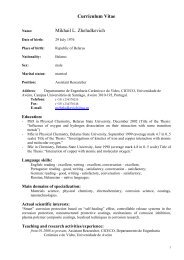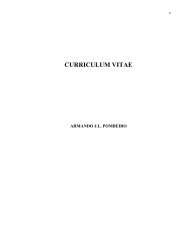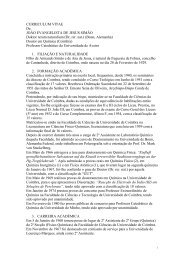XII Iberian Meeting of Electrochemistry XVI Meeting of the ...
XII Iberian Meeting of Electrochemistry XVI Meeting of the ...
XII Iberian Meeting of Electrochemistry XVI Meeting of the ...
Create successful ePaper yourself
Turn your PDF publications into a flip-book with our unique Google optimized e-Paper software.
<strong>XII</strong> <strong>Iberian</strong> <strong>Meeting</strong> <strong>of</strong> <strong>Electrochemistry</strong> & <strong>XVI</strong> <strong>Meeting</strong> <strong>of</strong> <strong>the</strong> Portuguese Electrochemical Society O B 03<br />
An electrochemical biosensor for toxic amides determination:<br />
Merits and Limitations<br />
Nelson A. F. Silva 1 , Manuel J. Matos 1 , Amin Karmali 1 , Maria Manuela Rocha 2<br />
1 CIEQB-ISEL - Instituto Superior de Engenharia de Lisboa, Portugal<br />
2 DQB Faculdade de Ciências da Universidade de Lisboa, Portugal<br />
nsilva@deq.isel.ipl.pt<br />
The present work reports some experimental results concerning an investigation that is<br />
presently being conducted in order to develop and implement an electrochemical<br />
biosensor for toxic amides determination [1].<br />
The biological recognition element consists <strong>of</strong> whole cells <strong>of</strong> Pseudomonas aeruginosa<br />
containing intracellular amidase activity, which catalyses <strong>the</strong> hydrolysis <strong>of</strong> amides, such<br />
as acrylamide, producing ammonium ions and acrylic acid.<br />
The transduction process is provided by an ammonium ion selective electrode.<br />
Whole cells were firstly immobilized in several types <strong>of</strong> polymeric membranes, such as<br />
polye<strong>the</strong>rsulfone, nitrocellulose, polycarbonate or nylon, which were attached to <strong>the</strong><br />
surface <strong>of</strong> <strong>the</strong> transductor according to different procedures. The reaction time was 6<br />
minutes. These biosensors, typically, exhibited a linear response in <strong>the</strong> range <strong>of</strong><br />
10 -4 -10 -1 mol.L -1 <strong>of</strong> acrylamide, a detection limit in <strong>the</strong> order <strong>of</strong> 10 -4 mol.L-1 <strong>of</strong><br />
acrylamide, and a sensitivity <strong>of</strong> 48.0 mV/decade. O<strong>the</strong>r figures <strong>of</strong> merit such as,<br />
selectivity, correlation coefficient, response time or half life time, concerning <strong>the</strong><br />
ility, were also investigated.<br />
<br />
example, <strong>the</strong> time needed for complete removal <strong>of</strong> ammonium ions from <strong>the</strong> vicinity <strong>of</strong><br />
<strong>the</strong> transducer, after <strong>the</strong> catalytic reaction, so that each assay could start with identical<br />
conditions, was about 45 minutes. This period <strong>of</strong> time is not compatible with continuous<br />
measurements or even environmental monitoring <strong>of</strong> acrylamide.<br />
In order to overcome this limitation, some investigation studies are being conducted<br />
regarding <strong>the</strong> development and optimization <strong>of</strong> o<strong>the</strong>r immobilization matrices for whole<br />
cells <strong>of</strong> Pseudomonas aeruginosa. Some main characteristics <strong>of</strong> <strong>the</strong>se matrices, such as,<br />
high substrate and product diffusion rates, easy removal <strong>of</strong> ammonium ions after each<br />
assay; biochemical compatibility with <strong>the</strong> biological recognition element and<br />
mechanical stability, should be accomplished.<br />
Glutaraldehyde, bovine serum albumin (BSA), gelatin, nafion, agarose, zeolites, sol-gel<br />
technology, alginates beds, and o<strong>the</strong>r immobilization agents and procedures, have been<br />
used and combined, to prepare several different immobilization matrices. [refs!]<br />
The results that we will present, bearing in mind <strong>the</strong> characteristics mentioned above,<br />
range from poor to frankly good.<br />
In future we hope to be able to use this biosensor for acrylamide and o<strong>the</strong>r toxic amides<br />
determination in food and environmental samples.<br />
References<br />
[1] Silva, N.; Gil, D.; Karmali, A.; Matos, M.; Biocat Biotransf, 2009, 27, 143.<br />
September, 811, 2010. ISEL - Lisbon 36








